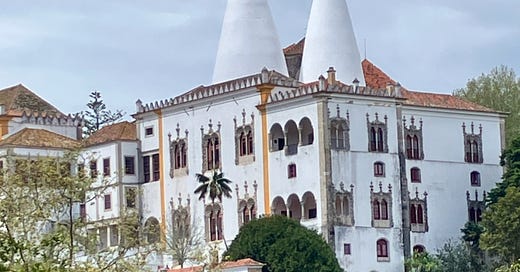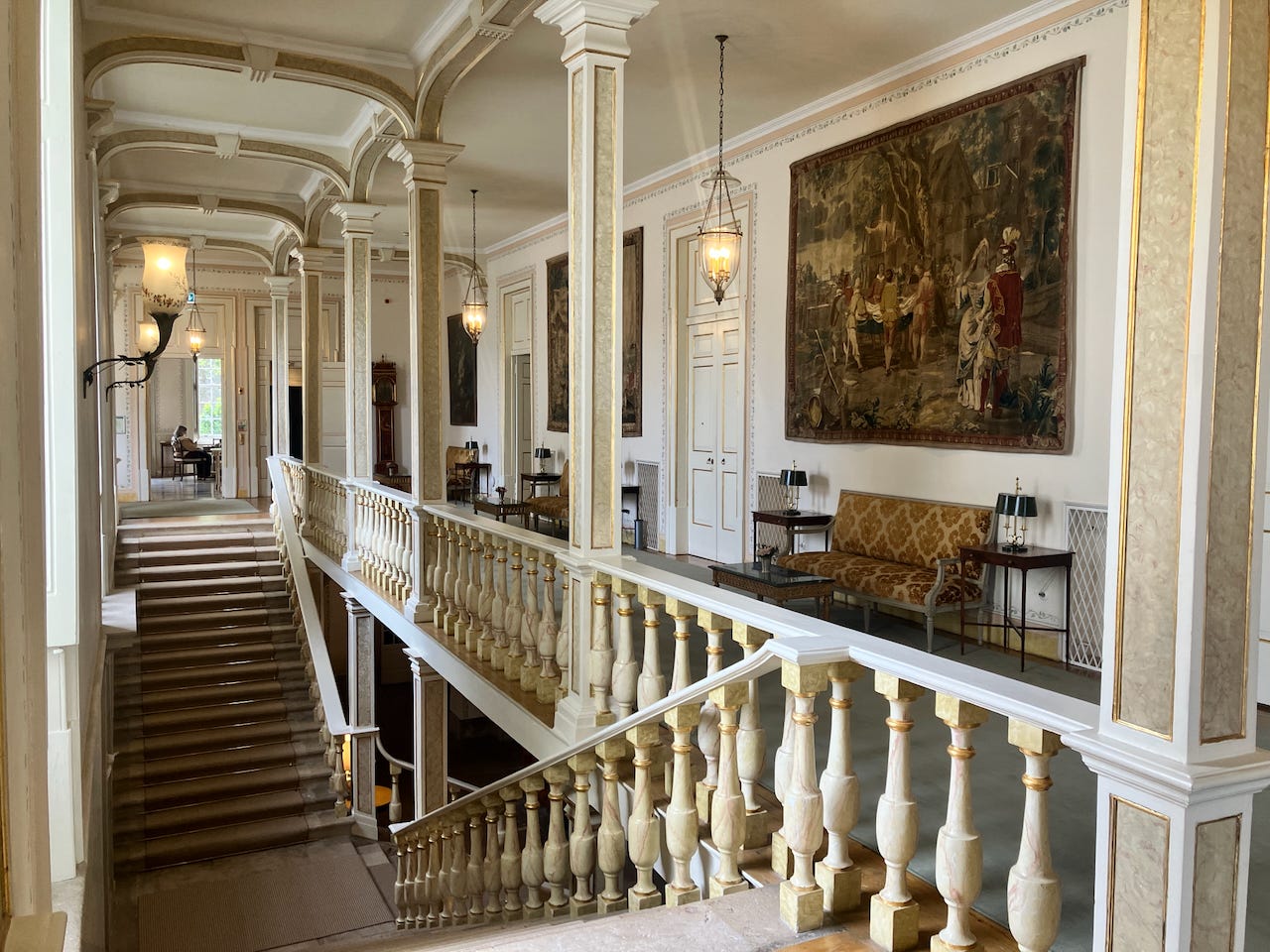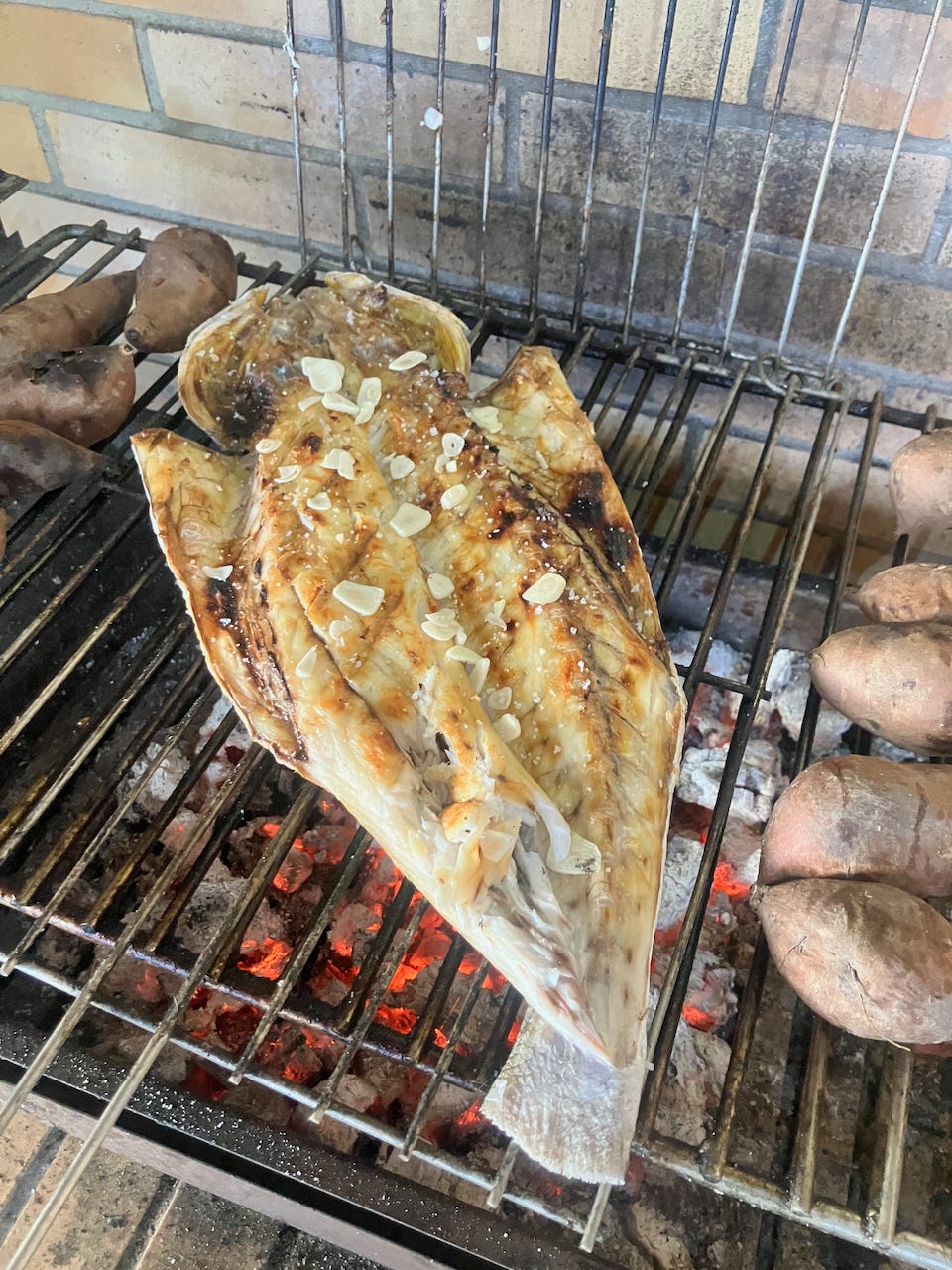Personal priests were on my mind when I visited Sintra in Portugal, because K and I had recently finished watching the lush Italian TV adaptation of The Leopard, based on Giuseppe Tomasi di Lampedusa’s extraordinary novel about a Sicilian prince navigating a shifting world in mid-19th century Italy. It's a wonderful book. The Italian series—available on Netflix—was excellent, even (or perhaps especially) because it took substantial liberties with the plot and characters. Now I’ve added the 1963 film adaptation to my list—directed by Luchino Visconti and starring Burt Lancaster—which my friend David calls a masterpiece. I could watch it for free on YouTube, but only in Italian without subtitles. I’ll probably end up renting it on Amazon Prime.
I didn’t know what kind of hotel K had chosen for us in Sintra, so I was surprised when we pulled up to some metal doors right off the center of town, block from the ornate City Hall. Sintra’s streets are tight, with limited or restricted car access, and hardly any parking. So it was with a sense of wonder that I watched the heavy metal gates, once we had raised someone to by phone, swing open. We drove into a sprawling estate whose grounds stretched forward and back from a big ornate mansion. On each side were other buildings, one of which held our suite of rooms. There was a a stone-set pool area, and orchards down a hill.
In the local terminology, this would be called a palace. It didn’t feel like a stretch.
It’s officially called Casa Holstein, Holstein being the family name. It’s now a hotel, although the desk clerk told me an aging family member still lives on the property—an aging family member who was once a well-known fado singer. That fact alone could be in a novel.
This family and its estate were once so prominent that visiting royalty from around Europe were regular guests. Framed photos throughout the house showed Princess Margaret of England and other royalty visiting, I’m guessing in the the 1960s and ’70s. King Juan Carlos of Spain, although perhaps before he officially took the throne, slept in our room.
The buildings and grounds looked better in the old photographs, and that’s not surprising. I can’t imagine what it would cost today to maintain a property like this well: not just the buildings, but the gardens, orchards, and extensive grounds.
Just to the left of the mansion stood a two-story chapel. It was locked, but I realized it must have been the family’s private chapel. Sort of like in The Leopard. From other travels and readings, I know private chapels and even private priests were once common among the nobility. In Prague, where we lived for a time, I visited several castles belonging to the Lobkowicz family, whose story fascinated me. One of their palaces include a chapel that felt more like a cathedral, so grand was it in both scale and decoration.
Speaking of castles and palaces, I think I’ve finally figured out how to use those terms correctly. A palace is a residence—like Buckingham Palace. A castle, on the other hand, is built for defense, often walled and fortified for soldiers. Palaces are typically homes of nobility, but not always. In Venice, for instance, I have seen many palazzos. I’m not sure where the line is between a big house and a palace, but somewhere along the way, a threshold is crossed.
Sintra, as we discovered over our four days and three nights, has many palaces—often sitting on what are called quintas, a word that can mean estate or farm. We visited several.
Palaces and a Castle
We started with the best-known: the Palácio da Pena, perched dramatically atop a mountain. Built in the mid-19th century by King Ferdinand II atop a ruined monastery, it was designed in the romantic style—whimsical, colorful, and instantly appealing. It’s gorgeous, though the crowds and timed-entry tickets wore on me. Why does heavy tourism, for me, feel like it sucks the life out of places? I dislike feeling like I am part of a crowd, waiting to see what I’m supposed to. I like discovering things, even if I’m not the first to do so.
Before that, we visited the Moorish Castle—mostly just walls now, but still impressive. It sits on a neighboring peak and can be seen from all over Sintra. The Moors abandoned it after the Christian reconquest of Lisbon in 1147. Full reconquest of what is now Portugal would take several more centuries, I believe.
EC and I toured the Sintra National Palace, right in the center of town—what locals call the Palácio da Vila. For some reason, many tourists skip it, as did K. It turned out to be my favorite. Portuguese kings and queens lived there as far back as the 1300s, and before that it was used by Moorish rulers. Room after room offered astonishing history and elegant furniture. Its most striking feature, visible from afar, is a pair of towering white chimneys. I assumed they were modern additions because they looked like modernist sculptures to me. But no, they’re original, serving the palace’s vast double kitchen. Inside, the kitchens looked like upside-down wine glasses, with the chimneys forming the stems. A plaque noted that one queen employed 29 cooks—not counting pastry chefs and bakers. I would give anything to see it all in action. All the wood-burning ovens and burners must have generated voluminous smoke, which was just sucked up overhead and then out the chimneys.
I had tickets to the Quinta da Regaleira, known for its mysterious spiral initiation well associated with the Knights Templar. But when the rain came, I didn’t feel like waiting in line outside.
Just up the street from the Regaleira, I pulled over to check directions and found myself in front of a horizontal estate stretched across a cliff with large grounds in front. I expected the guard to wave me off, but instead he invited me in. It was the Palace of Seteais—“Palace of Seven Sighs”—now a luxury hotel by the Valverde chain. I wandered its ornate grand rooms, decorated with original frescoes.
On our last full day, we spent the afternoon at Monserrate Palace, which K’s art group had recommended. Built by Sir Francis Cook, a wealthy Brit, around the same time as Palácio da Pena, Monserrate may have surpassed it. Cook’s summer retreat, designed in Moorish style, is surrounded by stunning gardens, lakes, and an underground water system feeding the entire property. The main house is stunning in its visual symmetry of Moorish arches. Even if you have the money, how could one design and build such a place? Kind of as a hobby? It seems a lifetime endeavor.
All of these places were remarkable, but it was the more modest Casa Holstein that helped me understand what Sintra was—and, in a way, still is. It was the summer refuge for nobility and the elite, where good and great families came to breathe mountain air and mingle with peers. At the top were royalty in the Palácio da Pena or the town palace. Just beneath them, Portuguese and foreign aristocrats built Seteais, Monserrate, and the Quinta da Regaleira. Then there were the other quintas, glimpsed through ornate gates as we drove by.
We were lucky to spend one afternoon with a local couple from Sintra. We’d met them at an outdoor wine dinner near our home and kept in touch. Though they’d lived in Sintra for years—and the husband, Ricardo, grew up there—they weren’t familiar with Casa Holstein, which to me was telling. Sintra has so many palaces that even this to me amazing one, right in the center of town, was not known to them. As we walked the grounds, Ricardo told me in effect that a private chapel was nothing special: many of the grand homes had them. He described one estate, now owned by a Japanese family, where the chapel is opened once a year to the public.
I’m so far removed from such a world that I can’t imagine wanting—much less needing—a private church or clergyman. But that they were once commonplace speaks to how deeply embedded religion was in people’s lives.
One big takeaway from our visit to Sintra which could be applied to many places: take your time. Many tourists come from Lisbon for the day, visit the Palácio da Pena, and leave. It’s only about 30 minutes by train or car (though parking is a challenge). But a rushed visit misses the point. I’m glad K agreed to extend our stay to three nights. I could easily have stayed a week—or a month.
By the mid to late 20th century, I believe most of Sintra’s noble families had to sell or abandon their estates. Rising taxes and labor costs made upkeep impossible. Cook’s grandson sold Monserrate after World War II. I was told the Seteais palace, built by a Dutch businessman, had been abandoned before the Portuguese government bought it up.
Are those times gone? We still have the ultra-wealthy—Elon Musk, Jeff Bezos—whose fortunes likely surpass those of 19th-century royalty. Some of them own impressive homes, sure. Bezos just sold one for $63 million, a state record. But they’re building rockets, not palaces, as their legacy projects.
I admire these magnificent estates of Sintra. I don’t resent the wealth behind them, even though I think a more even distribution of wealth is better.
Tummy Time: If It’s Not From Portugal, It’s Not In Portugal.
I savor Portuguese food, and I genuinely appreciate that, broadly speaking, there’s little else available where we live. I don’t want the world to become one giant “international style” food court.
Still, my irritation has joined my amusement and pride that so little from elsewhere is available in our corner of the Alentejo. Spain is a half day away by car, France a day, but it’s almost impossible to find Spanish anything, say a good sherry, or just a few half-decent French cheeses. The same goes with Italian products. Even those all these countries are part of the European Union, a free-trade zone. I savor the memories of Spanish vermouths found in Brooklyn, and Italian cheeses. Here, we drink Portuguese wine and eat Portuguese food. Full stop.
I shouldn’t complain. I grilled a beautiful corvina the other night and, in what I believe is the Portuguese style, sprinkled fresh garlic on it at the end. I served it with local sweet potatoes, grilled beside the fish. Maybe it wasn’t the French, Italian, or Spanish way. But it was very, very good.






You eat well
Ah Alex, you have described my Sintra experience to a tee. I will have to return.
"Many tourists come from Lisbon for the day, visit the Palácio da Pena, and leave."
PS. I have recently been toying with the idea of buying some vermouth from a recently opened distillery upstate, the Klocke Estate. My one concern is that I read that vermouth, unlike port and other spirits, does not have a long shelf-life. Would you and K polish the bottle off within a week or two? Not sure how long it lasts.